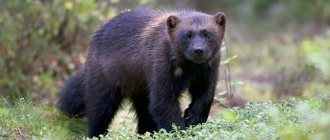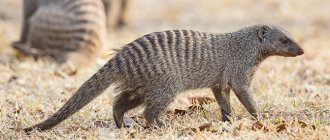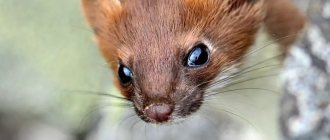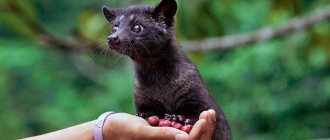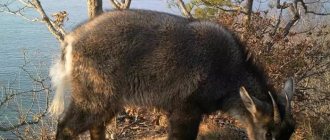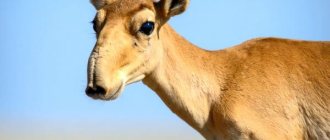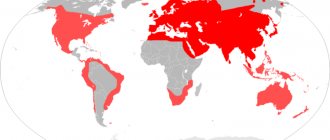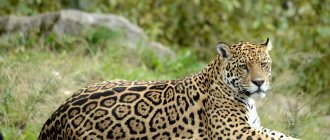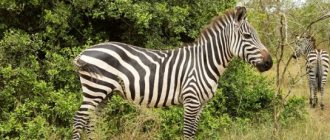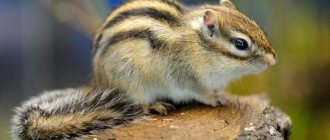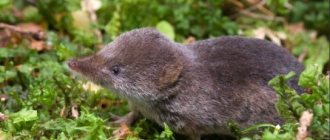- Wild animals
- >>
- Mammals
These small rodents, which in appearance resemble a cross between a hamster and a mouse, live in the tundra and forest-tundra of Eurasia and North America. Because of their appearance, they are also called polar pieds. They have motley fur with small gray-brown streaks. Lemmings serve as the main food for many polar animals, but due to intensive reproduction they quickly replenish their populations.
Origin of the species and description
Photo: Lemming
Lemmings belong to the order of rodents, the hamster family. The pied mice are very close to these small animals, so because of their external similarity to lemmings, they are sometimes even called polar pieds. In the current scientific classification, all lemmings are divided into four genera, each of which contains several species. There are five species of lemmings in Russia, and according to some sources, seven species.
The main ones are:
- Siberian (aka Ob) lemming;
- Forest Lemming;
- Ungulate;
- Amursky;
- Lemming Vinogradova.
Their classification is strictly scientific, and external species differences between animals are almost completely insignificant. Animals inhabiting islands are, on average, slightly larger than mainland individuals. There is also a gradual decrease in the size of lemmings living in Russia, in the direction from west to east.
Video: Lemming
Fossil remains of the ancestors of modern lemmings have been known since the late Pliocene. That is, they are approximately 3-4 million years old. Much younger fossils are often found in Russia, as well as in Western Europe outside the current range of lemmings, which is likely due to significant climate change.
It is also known that approximately 15 thousand years ago there was a change in the structure of the molars of these animals. This correlates with data that at the same time there was a sharp change in vegetation in the zones of modern tundra and forest-tundra.
Popular message topics
- Scientists of Russia
Many scientists who made a huge contribution to the development of humanity were from Russia. Probably, the greatest scientist in the world can be called Dmitry Ivanovich Mendeleev, the creator of the periodic table of chemical elements. - Genetics Genetics
as a science originated in the 19th century, its discoverer was Gregory Mendel. He revealed to the whole world the discreteness (separateness) of hereditary factors. He proved that in the structure of every living organism there are so-called genes - Ussuri Nature Reserve
In the Primorsky Territory, not far from the city of Ussuriysk, the famous Ussuri Nature Reserve is located. Huge, diverse forests occupy a large area here, which are perfectly complemented by high mountains and rivers flowing nearby.
Appearance and features
Photo: Lemming animal
Almost all lemmings have a dense and fairly well-fed physique, regardless of the area in which they live and which subspecies they belong to. An adult lemming reaches 10-15 centimeters in length and has a body weight of 20 to 70 grams. Males are slightly heavier than females, by about 5-10%. The tail of the animals is very short, no more than two centimeters in length. The legs are also quite short. When constantly fed to their fill, the animals become noticeably fatter.
The lemming's head has a slightly elongated shape with a somewhat blunt, snub-nosed muzzle, very similar to a hamster's. There is a long front molar. The eyes are small and look like beads. The ears are short and hidden under thick fur. By the way, the fur of these animals is very soft, but dense. The hairs are of medium length, but are located quite densely, so the coat of the polar rodent is very warm. It is she who helps lemmings survive in the Far North.
The color of the fur of animals is quite diverse and depends on the time of year. In summer, the skins of lemmings are colored, depending on the subspecies and habitat, either a solid beige color or grayish-brown, or have a variegated brown-yellow color with dark spots on the back, with a sand-colored belly. In winter, the color changes to light gray, less often to completely white.
Characteristic
Lemming is a small rodent that is a member of the hamster family. There are about 20 species in total.
The animal moves on short legs, on which claws grow closer to winter. The animal uses them to dig through the snow, extracting food from under it.
The Lemming looks very cute, as he is dressed in a fluffy fur coat that completely hides his small ears.
Its variegated color allows it to camouflage perfectly in the grass in the warm season - this can be seen in the next photo.
Compact and fast, the lemming becomes inconspicuous on the forest floor
Representatives of some species molt and become lighter with the onset of cold weather.
Thanks to this, the animal, like the arctic fox , almost completely merges with the snow.
Where does the lemming live?
Photo: Lemming in the tundra
These rodents prefer to live in tundra and forest-tundra zones. They are found almost everywhere in the coastal Arctic. They inhabit the northern regions of Eurasia and North America, for example, in Russia they are distributed throughout the northern territory from the Kola Peninsula to Chukotka.
Quite large populations of lemmings are present on some coastal areas of the Arctic Ocean, especially those located in the deltas of large Siberian rivers. The animals are also found on the island of Greenland and Spitsbergen, which are quite distant from the mainland.
Where the lemming lives, there is almost always marshy terrain and humidity. Although they are resistant to cold, they are still quite sensitive to the climate and overheating is very dangerous for these animals. But they are sufficiently adapted to overcome small water obstacles. They often settle on peat mounds with extensive grassy vegetation among marshy areas.
Animals do not migrate seasonally; they remain in their habitats. But in hungry years, lemmings in search of food are able to leave their native places and migrate over considerable distances. A characteristic feature of this is that migration is not a collective decision, but each individual tries to find more food only for itself. But due to the large number of animals during such migration, they resemble one large living mass.
Geographical distribution
Photo: lekkiM
These mammals live in the Northern Hemisphere , throughout the arctic and subarctic regions of North America, Greenland, Russia, Norway, Sweden, China, Mongolia and many other countries. There is a wide variety of species, and each has its own unique geographic distribution. Some species are much more widespread, while others live in small, restricted populations.
- Biogeographic regions: Palaearctic (native)
What does a lemming eat?
Photo: Polar Lemming
Lemmings are herbivores. They feed on all kinds of berries, roots, young shoots, and grains. These animals are very fond of moss. But most of the food of polar rodents is green moss and lichens, widespread throughout the tundra.
Depending on the specific subspecies, their diet may include:
- Sedge;
- Blueberries and lingonberries;
- Blueberries and cloudberries;
- Some mushrooms.
Rodents often eat the buds or leaves of dwarf trees and shrubs typical of the tundra, as well as their branches and bark. In the forest-tundra, animals feast on young shoots of birch and willow. Less commonly, lemmings may eat insects or shells that have fallen from a bird's nest. There are also cases where they try to gnaw on the antlers shed by a deer. In winter, the root parts of plants are eaten.
The lemming feeds around the clock with breaks for sleep. In fact, at a satisfying time in 24 hours, he is able to eat such a large amount of plant food that its mass begins to more than double the animal’s own weight. Because of this feature, rodents cannot live in one place all the time, and therefore they are forced to constantly move in search of new food.
On average, an adult lemming consumes about 50 kg of various vegetation per year. At the peak of their numbers, these animals have a fairly strong impact on the vegetation in their places of residence, destroying almost 70% of the phytomass.
Diet
Lemmings are herbivores that are not too picky about what they eat. Like voles and muskrats, lemmings feed primarily on leaves, shoots, roots, plant bulbs and moss. Their diet includes herbs, shrubs, berries and mushrooms. Sometimes they do not disdain insects. Like all rodents, lemmings' incisors grow continuously throughout their lives. This allows them to eat very tough plants.
Photo: weird square
Lemmings are thrifty animals. They bury mosses, grasses and sedges in underground storage facilities . Therefore, in winter, instead of collecting food in their tunnels like pikas, lemmings dig under the snow and look for previously buried food.
Features of character and lifestyle
Photo: Northern Lemming
Lemmings lead a predominantly solitary lifestyle. Married couples are not created, and fathers do not take any part in raising their offspring. Some subspecies can unite in small groups, but the association only concerns living together. Crowding is more typical in winter. But the animals do not provide any mutual assistance to each other within the colony.
During the snowless period, female lemmings become well expressed in territoriality. Males do not have their own territory, but simply wander everywhere in search of food. Each of the animals sets up their home at a considerable distance from the other, since they absolutely do not tolerate anyone else near them, with the exception of mating time. The internal relations of lemmings can be characterized by social intolerance and even aggressiveness.
During the summer and off-season, lemmings live in burrows. They are not full-fledged burrows, and it would be more correct to call them simply recesses. They also use other natural shelters - spaces between stones, under moss, between stones, etc.
In winter, animals can nest right under the snow in natural voids that are formed due to the steam rising from the still warm ground immediately after it is covered with the first cold snow. Lemmings are one of the few animals that do not hibernate. Under the snow, they can dig their own tunnels. In such shelters, polar rodents live all winter and even reproduce, that is, they lead a quite active lifestyle.
Interesting fact. In winter, the lemmings' neighbors in their homes are polar partridges, which also actively populate the snowy areas.
The activity of rodents is round-the-clock and polyphasic. The rhythm of life of lemmings is quite high - their activity phase is three hours, that is, the human calendar day corresponds to eight three-hour days of these animals. They follow their daily routine very strictly. Feeding lasts an hour, then sleeps for two hours. The cycle then repeats regardless of the position of the Sun and ambient light. However, in conditions of the polar day and polar night, a 24-hour day loses its meaning.
Lifestyle
Small rodents like to travel alone. They live in makeshift burrows. There are species that inhabit natural refuges.
Active lemmings do not sleep in winter. They tolerate cold well. In summer, the animal searches for food, which it hides in the ground. In winter, with their paws, they dig tunnels in the thick snow, in search of hidden food, and thus spend the winter.
Lemmings gather in groups only during mass migrations. This happens from time to time when the inhabited areas run out of food. Then they are forced to migrate in search of lands richer in food. During the relocation, many animals die. Losses in numbers are quickly restored due to the high fertility of females.
Social structure and reproduction
Photo: Lemming forest
Lemmings live quite a short life, only one or two years, and they die not from old age, but mainly from predators. But nature has adapted them to bear good offspring in this short time. Some of them manage to bear offspring 12 times during their lives, but this is under the most favorable conditions. More often, reproduction occurs only 3 or 4 times a year. Each time five or six cubs are born, sometimes up to nine. Pregnancy lasts quickly, only 20-21 days.
It is interesting that these animals also begin to reproduce early - from the second month of life and do this every two months. Males are also capable of fertilizing females very early. Moreover, no weather conditions limit lemmings from reproducing; they can do this both in favorable weather and in severe frosts, being under the snow in burrows. In these same snow holes, new cubs can be born and wait for their release into the world.
It is worth noting that other predatory animals watch the reproduction of lemmings, because they are the main source of food for them. For example, owls may even decide not to lay eggs if they see that the number of lemmings is too small to easily get them and their cubs for lunch at any time.
Of course, lemmings do not have any preferences in choosing sexual partners; their life is short, they mate with the first one they come across and do this during breaks from eating and wandering. Thus, it turns out that their life comes in a hurry, to bring as many offspring as possible and the rest of the time is taken up by food and shelter. The cubs do not stay with their mother for long on her territory, but very soon they become sexually mature and run off to fulfill their vital function.
Of course, many individuals die early in life from predators, which is why they require a large number of offspring so that they are not completely eaten.
Natural predators
Arctic rodents have a large number of predators. From snowy owls and seagulls to wolverines and polar bears, lemmings offer a tasty protein snack for predators!
Photo: Denver Holt
These are very important animals in their ecosystems. The well-being of most carnivorous animals of the taiga and tundra depends on their quantity. In years when the lemming population is very low, Arctic foxes and stoats have fewer young. Lemmings also influence the populations of hawks, gyrfalcons, foxes and wolves.
Natural enemies of lemmings
Photo: Lemming in Russia
Lemmings have a lot of enemies - predatory animals. For most predatory polar inhabitants they serve as the main source of food: for arctic foxes, foxes, peregrine falcons, stoats, as well as for birds:
- Polar owls;
- Skuas;
- Krechetov.
These predators directly link their existence and food supply to the state of the lemming population. Moreover, if the rodent population falls, then predators can even deliberately reduce their birth rate if they discover a shortage of lemmings in a certain period. In this way, the entire ecosystem ends up being well balanced.
In addition to dying in the mouth of a predator, a rodent can die in another way. When lemmings migrate, their actions become self-destructive: they jump into the water and drown, putting themselves in danger. They also run continuously on open surfaces without shelter. After such migrations, the bodies of drowned lemmings often serve as food for fish, marine animals, seagulls, and various scavengers. They all rush to replenish energy reserves in such large-scale death zones.
In addition to ordinary predators, for which lemmings form the basis of their diet, at certain moments completely peaceful herbivores may show a food interest in them. Thus, it was noted that, for example, deer may well eat lemmings to increase protein in the body. Of course, these are rare cases, but nevertheless they happen. Geese have also been observed eating these rodents, and they eat them for exactly the same purpose - from a lack of protein.
Sled dogs also feast on lemmings. If in the process of their work they find a moment to catch an animal and have a snack, then they will certainly take advantage of this opportunity. This is very convenient for them, given the complexity and energy consumption of their work.
It is interesting that when meeting both a person and many other animals, many lemmings do not run away, but rather often jump in their direction, then rise on their hind legs and squeal shrilly, trying to scare the enemy.
Habitat
Lemmings are the smallest representatives of Arctic mammals . However, the well-being of most predators in Arctic ecosystems depends on them. Most of the rodents' habitat is covered by permafrost. In their native region, the soil often freezes within a few centimeters. So it’s not easy for lemmings even in the summer, because digging deep tunnels for shelter in such conditions is extremely difficult. The only solution is to wait for the seasonal freezing and thawing of moist soils, which creates ridges and depressions suitable for use as shelters and travel routes.
Photo: Andrey Zvoznikov
With the onset of spring and the melting of snow covers, lemmings migrate to areas of forests and mountains. Moreover, different species in the same habitat area usually prefer different places of residence in the summer. For example, hoofed lemmings choose dry areas at higher elevations, while yellow-bellied lemmings choose lowlands with moist soil. This segregation is determined by the location of the preferred food supply; for example, hoofed lemmings will seek out cranberries and willow branches, while their yellow-bellied cousins will prefer sedges and arctic moss. During the winter, habitat segregation tends to change as ungulate species migrate to lowlands where there is deep snow that provides more cover.
- Habitat: temperate, polar
- Terrestrial biomes: tundra, taiga and cold steppe grasslands
Species diversity
Taxonomists count about 20 species of these animals, of which only 7 live on the territory of Russia. Among the latter, the most common are Siberian, forest, ungulate and Amur. It is worth saying that their species differences are not significant at all. Let's look at some of them.
Hoofed lemming
This species is easily recognized by the shape of the two middle nails of the front paws. They grow significantly and become like a fork. Another distinctive feature is the black stripe. It runs along the back. Another stripe is on the neck. Visually it resembles a light collar. In general, the color of the hoofed lemming has ash-gray shades with red spots on the sides and a gray belly. In winter, the animal changes its coat color to white.
Where does this species of lemming live? Its distribution area is quite wide. It begins on the eastern coast of the White Sea, includes numerous islands, and stretches to the Bering Strait. The hoofed lemming feels comfortable in the tundra with a lot of moss, dwarf willows, birches and wetlands. Its diet includes young shoots and leaves of plants, blueberries and cloudberries.
For the winter, hoofed lemmings make significant reserves of food in their burrows. These are one of the representatives of the species that live under the snow in small groups in winter. Being the main food of many polar animals, they also have a negative meaning. Hoofed lemmings are natural carriers of infectious diseases such as tularemia and leptospirosis. Not only animals, but also humans are susceptible to them. They can become infected with pathogens through a bite, direct contact, or through contaminated water, food or straw.
Norwegian Lemming
An adult grows up to 15 cm . Inhabits the mountain tundra of the Kola Peninsula and Scandinavia. Migrating, it goes deeper into the taiga and forest-tundra.
The main emphasis in nutrition is on green moss, cereals, moss and sedge, without giving up lingonberries and blueberries.
It is variegated in color and has a bright black line on its yellowish-brown back. Being lazy to dig holes, it looks for natural shelters, where it breeds numerous offspring: up to 7 children in one litter. In spring and summer, a female Norwegian lemming gives birth to up to 4 litters.
Forest Lemming
The hallmark of this species is the presence of a brown spot on the back. In general, the color of the animal is blackish-gray. The place where the lemming lives is the taiga zone of northern Eurasia. These are mixed and coniferous forests with a thick moss litter. In it, the animal makes numerous passages that continue outward with paths. Its burrows can be found in hummocks of moss or the roots of old trees. The forest lemming lives up to two years a year, bringing 5-6 cubs in a litter.
Siberian lemming
This species does not change its color in winter. The Siberian lemming is quite large. It is about 16 cm long and weighs more than 100 g. It is found on the territory of the Russian tundra and numerous islands of the Arctic Ocean. On the red body of the Siberian lemming, a black stripe is clearly visible that runs along the back. Its food is green mosses, small shrubs, cotton grass and sedges. For the winter, they make significant reserves of food in snow chambers or nests, which they construct from leaves and straw. The Siberian lemming is an important component of the tundra food chain. For white owls, skuas, weasels, arctic foxes, and ermine, they are the main food.
Amur lemming
Does not grow more than 12 cm . This rodent can be recognized by its tail, which is as long as its hind foot, and the hairy soles of its paws. In summer, the body is brown, diluted with red spots on the cheeks, lower surface of the muzzle, sides and abdomen. A black stripe is visible from above, which becomes very thick on the head and as it moves to the back.
In winter, this stripe is practically invisible, and the fur becomes softer and longer, acquiring a uniform brown color with slight splashes of gray and red. Some Amur lemmings have characteristic white markings on the chin and near the lips.
Lemming Vinogradova
This is a prime example of an endemic species. It lives only on Wrangel Island, where it is protected by a local nature reserve. This species is named after Boris Stepanovich Vinogradov, a famous Soviet zoologist. His area of research was theriology, which is the science of mammals. This species was once a type of hoofed lemming. Its distinctive feature is its elongated head and wide nape. In winter it turns from gray to snow-white.
